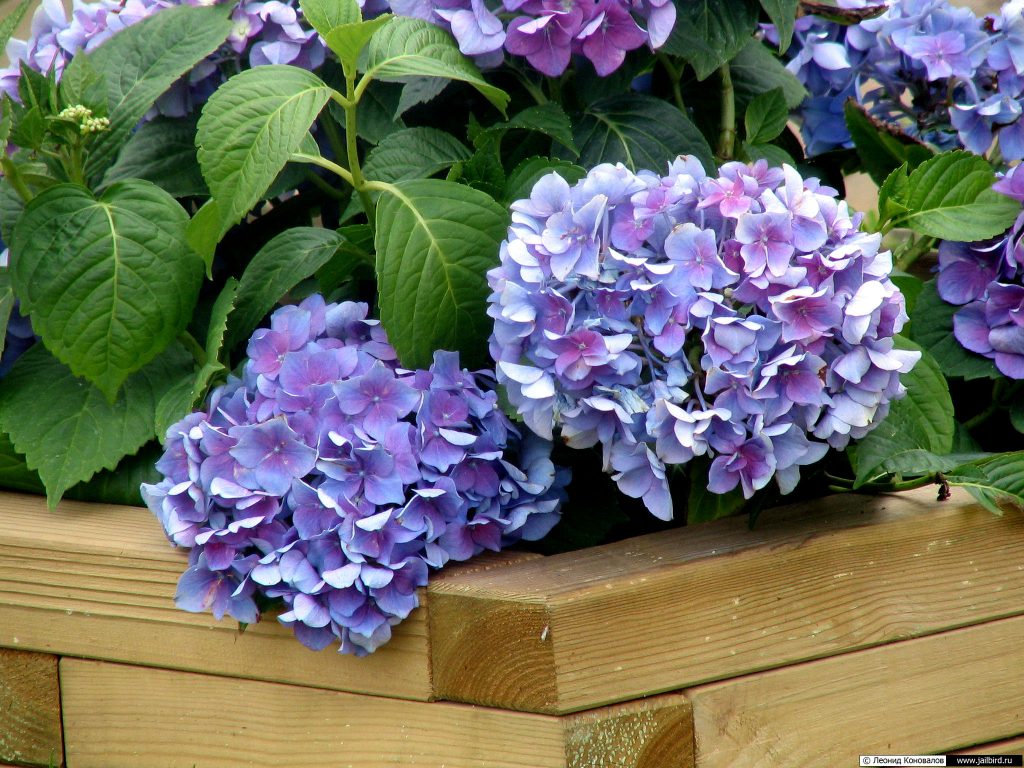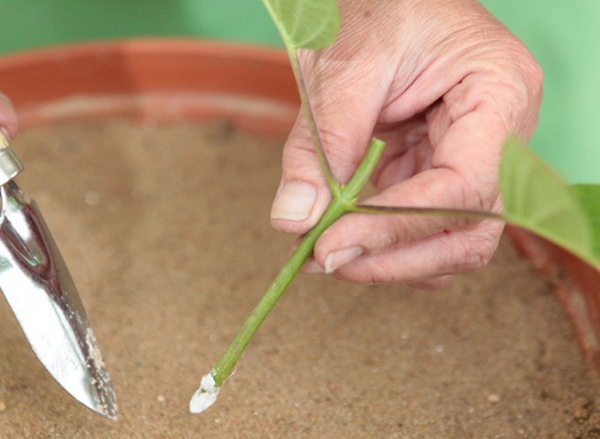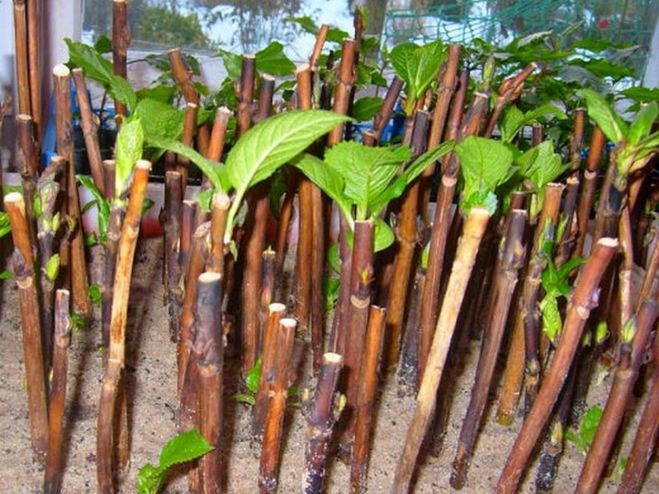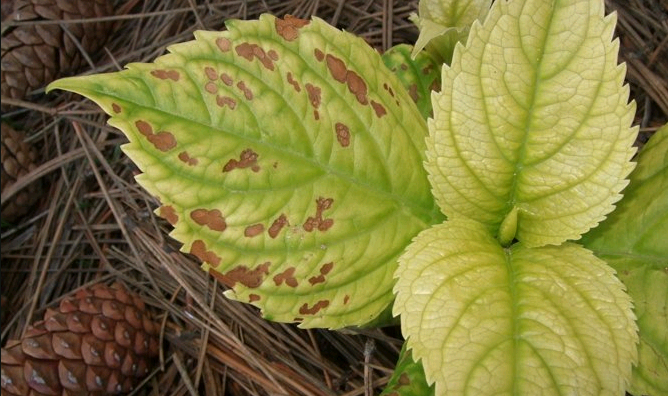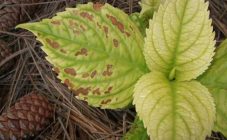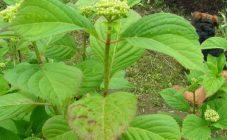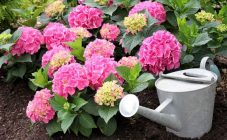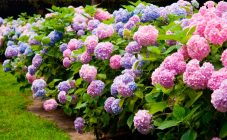Content:
Whoever sees a blooming hydrangea will be amazed with delight and want to collect these beautiful airy flowers in a bouquet. This magnificent flower blooms from July to August, some varieties can please the eye until late autumn. Others really want to decorate their personal plots with this plant. This article will tell you how to do this.
What does hydrangea love
The choice of a place for planting hydrangeas depends on the climatic conditions in which it will grow. If the plant is planted in the south of Russia, then a place is chosen where the flower will be in partial shade. Naturally, it will feel good in sunny areas, but in this case it will be necessary to water the plant often.
In central Russia and in the northern regions, this flower is best planted in direct sunlight or use an openwork shade.
It is better to start planting hydrangeas in the spring, even before the buds bloom on the bush. Thus, the root system will root well over the season, and the plant will subsequently be able to calmly overwinter. The flower loves soil acidic and abundantly moist.
The pits are dug thirty centimeters in length and width and at the same distance in depth. After that, a planting mixture is prepared from soddy soil, sand and fertilizers. Peat is also added here. A plant is planted, while in no case is the root collar added. The soil surface in the root zone must be thoroughly watered and mulched. It is imperative to cut off annual shoots, while leaving no more than three buds.
Be sure to cut long roots during planting, remove damaged and dried ones. Care should be taken to ensure that they are all the same length. If the root system is tangled, then it must be straightened and evenly distributed in the fossa.
Hydrangea is planted in a separate bush or in several groups. If the second planting option is used, then you need to maintain a distance of one meter between the plants.
Reproduction of hydrangea
Many people want to have this beautiful flower in their garden, but do not know how to plant a hydrangea correctly. The flower propagates in several ways:
- Seed and grafted. But these methods of propagating a flower are used extremely rarely.
- Layers. To do this, you need to take shoots that are no more than one year old, and bend them to the soil surface. Sprinkle it with earth, leaving no more than twenty centimeters of the top. During the season, the shoot will take root, after which it can be separated from the mother bush and transplanted to a permanent place.
- By dividing the bush. In this way, you can propagate the culture only in autumn or spring. Before dividing the hydrangea bush, it must be dug from the ground and divided into several parts. But before planting a hydrangea bush, you need to make sure that each part has a renewal bud. Then the plant is planted in the planned locations.
- Hydrangea cuttings. There are two such ways: spring - the process of breeding hydrangea falls in April or June, and winter.If anyone wants to know how to cut a large-leaved hydrangea, then a few words about this method. In October, you need to dig up the plant and transplant it into a pot. After that, the flower is brought into a room where the air temperature should not rise above two degrees Celsius. From the first days of January, the air in the room begins to warm up so that the temperature rises to ten degrees Celsius. Already in February, young shoots become mature and can be used for cuttings. Cuttings are cut in such a way that they have no more than two internodes. Then the cutting is prepared for planting. To do this, cut off the two bottom sheets, shorten the rest by half. The lower part of the cutting should be treated with a preparation that stimulates the formation of the root system, then planted in prepared pots. Be sure to cover the cuttings with jars or plastic bottles.
Hydrangea cuttings
Many gardeners are interested in the question: "how to grow a hydrangea from a cuttings?" This is perhaps the easiest and most popular method for those who know how to breed hydrangeas. This method is suitable for any type of flower. If a grower saw an interesting look from his neighbor, then, having asked for a cutting, he will quickly grow exactly the same flower on his site.
It is most convenient to graft tree and panicle hydrangeas. Moreover, in this case, you can form a shrub or even a tree at your discretion.
Before grafting a hydrangea, you need to prepare the material. To do this, in the last decade of May or early June, cuttings are prepared: the tops of young shoots that have grown this year are cut off. They are also called spring.
Material for cuttings can be harvested in mid-July. In this case, the shoots should be already stiff. Rather, their lower part should be woody. Such cuttings are called summer cuttings.
Hydrangea cuttings instruction
The shoot must be cut in such a way that no more than three pairs of leaves are located from the top to the bottom edge. In this case, the lower pair should be at the very bottom, closer to the cut. These two leaves must be completely cut off. Cut off half a sheet on the remaining pairs.
Soak the lower part of the cutting in root stimulants. You can use Epin's solution, one milligram of which is diluted in two liters of water. Cuttings in it must be kept for at least ten, or even twelve hours. Or, take one or two drops of HB101 and dissolve it in one liter of water. In this case, the cuttings are soaked for only half an hour. If anyone is interested in the question of how to quickly root a hydrangea with cuttings, then you need to follow further advice.
The place of the lower cut is sprinkled with another stimulant, which speeds up the process of root formation. It is called Kornevin or Ukoreit. Planting material is planted in the prepared soil at an angle of no more than forty-five degrees. At the same time, they deepen it by three or four centimeters. Be sure to make sure that the leaves of the cutting do not touch the soil surface. The cuttings themselves need to be sprayed with water.
Dishes with cuttings must be covered with a plastic bag or jar and placed in a place where there will be a lot of shade and the sun's rays will not be able to dry out the soil. With optimal weather and air temperature no higher than twenty-five degrees during the day and fifteen degrees at night, rooting will be completed in a month.
Then the seedlings must be transplanted into separate pots, where a mixture of garden soil, peat and sand is poured. The ratio should be 2: 2: 1. They put it back in the shade so that the plant grows further and begins to develop.It is imperative to water the flower, and in the winter, dig into the ground with the pot. Thus, the not yet fully formed root system will be protected from frost.
In the spring, the plant will begin to grow, then it can be planted in open ground. For this, a hole is prepared, in which a tablespoon of mineral fertilizers is placed, which include:
- nitrogen;
- phosphorus;
- potassium.
Fertilizers are thoroughly mixed with the soil. Before replanting the plant in the ground, it is not watered for 24 hours. Then it can be removed from the pot along with a lump of earth. It is recommended not to expose the root system when planting.
After planting a seedling, you need to cut off two-thirds of its stem. Thus, a lush bush will form. If the gardener wants to get a tree, then the trunk should be left as it is.
Growing a plant in this way is much easier than using cuttings, since in this case the root system has already been formed, although the growing process itself is similar to cuttings.
How to properly care for your culture
When growing hydrangeas, you must adhere to the rules of care:
- When feeding the plant, you must try not to overdo the soil, because in this case the plant will grow magnificently, and the inflorescences under their own weight will bend or break branches.
- Only slurry or humus is used as organic fertilizers.
- Hydrangea is a flower that loves moisture very much, so it needs to be watered regularly. In this case, the acidity of the water should be 5.6 PH, not higher.
- Over the summer, the soil near the plant should be loosened no more than three times. The loosening depth should be between five and ten centimeters.
Pruning is important for this plant. It is recommended to do it in the spring, during the period of swelling of the kidneys. In autumn, pruning young shoots is necessary in order for the plant to successfully overwinter. All branches are cut off on old bushes. If the gardener wants to get a compact tree, then in this case, purposeful formative pruning should be applied. This process has been going on for several years.
It is also interesting that this plant can change the color of its flowers. For this, gardeners use the following methods:
- To obtain blue flowers, the culture should be watered twice a week with a solution in which a tablespoon of aluminum, iron or aluminum sulfate crystals is diluted into five liters of water.
- A pink tint will give potassium permanganate.
- Peat also affects the color of the flowers of a given crop. Moreover, it is also an excellent fertilizer.
It is important to cover the plant for the winter. Thanks to this, the buds intended for the development of inflorescences will be preserved. The covered plant will bloom much earlier next year.
Expert advice
When growing hydrangeas by cuttings at home, many may encounter problems when the plant does not bloom or begins to die. What to do in such cases, advice from experienced specialists will tell you.
Hortense began to turn yellow. What is the reason? In this case, you should revise the rules for caring for the plant. Most often, the reason for the change in leaf color may be the absence of a substance such as nitrogen in the soil. In this case, the situation can be corrected by the introduction of nitrogen fertilizers. Or the soil under the plant is alkaline. Then it needs to be slightly acidified, and the problem will disappear.
The plant dries up.Most often, this problem occurs due to the fact that the owner forgets to water the crop. But there are more serious reasons. Namely, the flower lacks nutrients, or the root system has been damaged. But be that as it may, the reason for everything is improper care of the flower. Therefore, first of all, you need to follow the rules for care, then all the problems listed will be eliminated.
The culture stopped blooming. The reason for this, most likely, may be a complete expenditure of strength. This happens when the plant is grown indoors, and in the winter it did not rest, but bloomed magnificently. In order for the flower to please the eye with flowers again next year, it needs a vacation of at least eighty days. If the plant does not even think to rest in December, in this case it must be properly prepared for the next season. To do this, all the leaves are removed, the weak branches are trimmed, and the flower is taken to the basement, where it lies on its side. Only in February can it be brought back to the room. Thanks to this ritual, the culture will bloom and savor again.
It is not difficult to grow a hydrangea using cuttings at home. The main thing is that all the rules of planting and care are followed. Then the garden in the country will be decorated with wonderful balloons of flowers.
